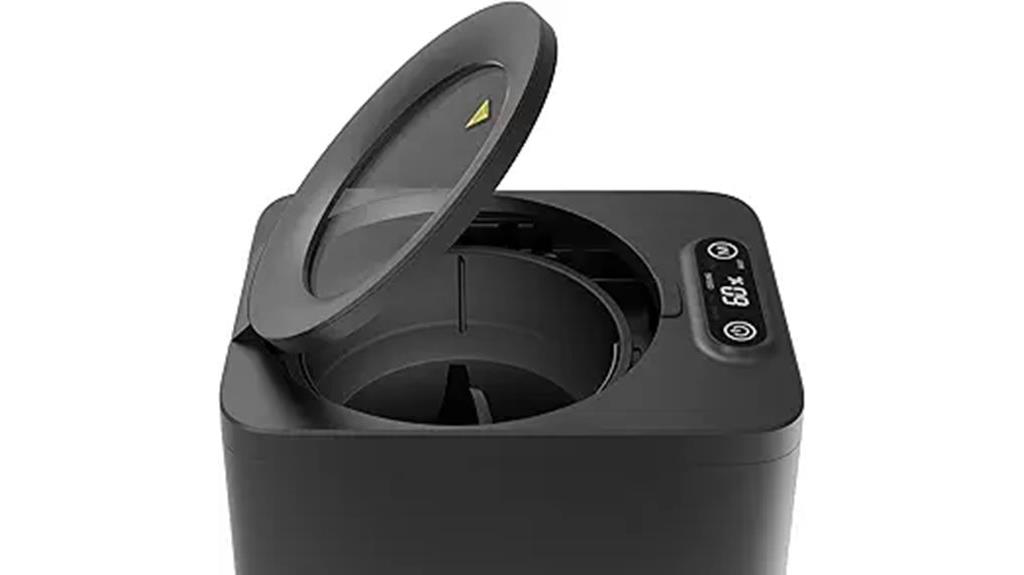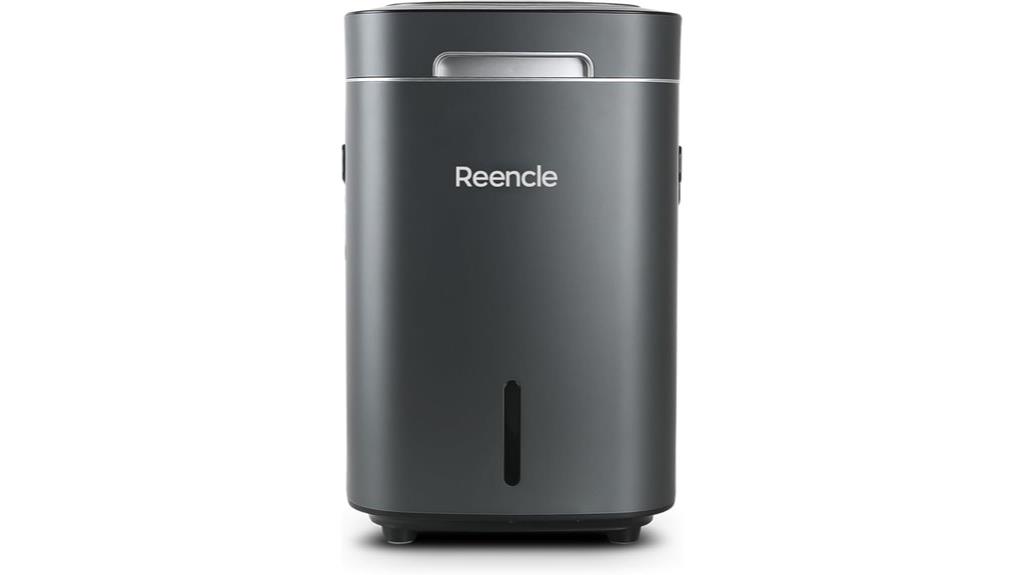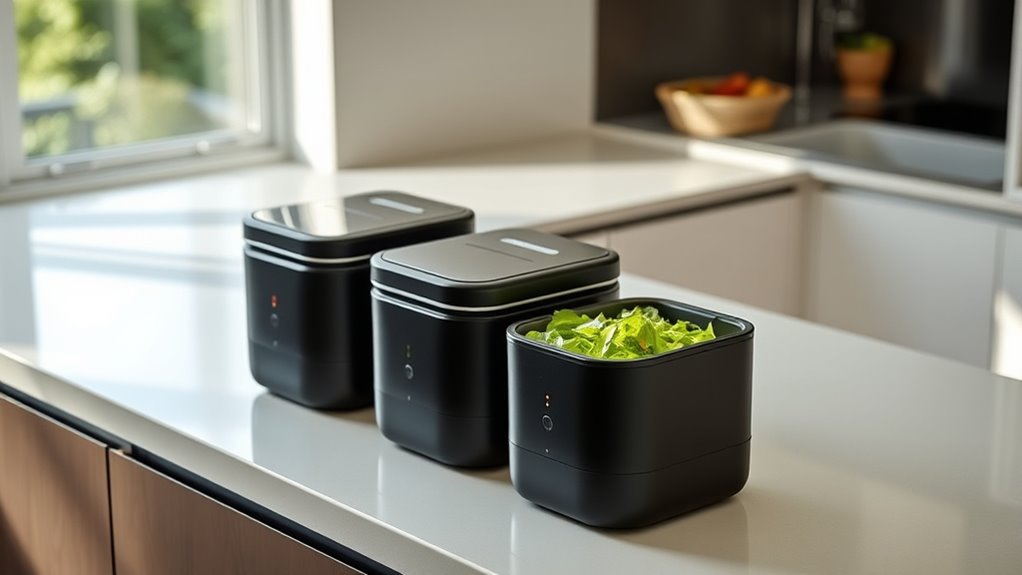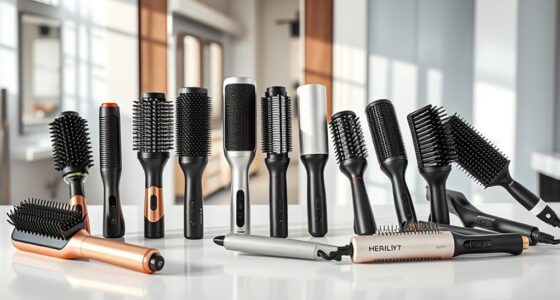If you’re looking for eco-friendly, convenient ways to manage kitchen waste, I recommend the Electric Kitchen Composter, CREATIVECHEF, and Reencle Prime models. The compact 3L and 3.8L bins are perfect for small spaces and quick composting, while the larger 14L Reencle Prime handles more waste with ease. Each offers odor control, quiet operation, and simple maintenance. Keep exploring to find out which option best fits your needs and home setup.
Key Takeaways
- Consider models with sufficient capacity (3L to 14L) to match your household waste volume and space availability.
- Look for features like odor control (activated carbon filters, UV sterilization) and quiet operation (28-46 dB).
- Choose user-friendly units with one-touch controls, auto-cleaning, and clear indicator lights for easy maintenance.
- Opt for efficient composting speeds (2-6 hours) with reliable microbial activity for quick waste transformation.
- Prioritize durable, warranty-backed models for long-term, eco-friendly kitchen waste management.
Electric Kitchen Composter, 3L Indoor Smart Food Waste Recycler

If you’re looking for an easy, space-saving way to manage kitchen waste, the Electric Kitchen Composter with a 3L capacity is an excellent choice. This compact, countertop recycler handles daily food scraps like vegetable peels and leftovers efficiently, transforming waste into usable compost in just 4-6 hours. Its sleek design fits neatly on your counter, saving space while reducing waste volume by up to 90%. With features like an LED display, one-touch operation, and self-cleaning mode, it’s user-friendly and low maintenance. Quiet and odorless, it’s perfect for indoor use and supports eco-friendly living effortlessly.
Best For: eco-conscious households and gardening enthusiasts seeking a compact, efficient, indoor food waste recycling solution.
Pros:
- Compact and space-saving design perfect for countertop use.
- Transforms food waste into compost within 4-6 hours, reducing organic waste by up to 90%.
- User-friendly features like LED display, one-touch operation, and self-cleaning mode for easy maintenance.
Cons:
- Limited 3L capacity may require frequent emptying for larger families.
- Plastic build, though durable, may not appeal to those preferring more eco-friendly or premium materials.
- May generate some noise during operation despite being designed for quiet use.
CREATIVECHEF Electric Composter (3.8L Indoor Smart Odorless Compost Bin)

The CREATIVECHEF Electric Composter is an excellent choice for anyone seeking a compact, odorless indoor waste solution. Its 3.8L capacity fits comfortably on a countertop, handling larger loads efficiently in a single cycle. With one-button operation and an auto-clean function, it’s simple to use—just press, lock, and clean with minimal effort. Activated carbon filters guarantee odors stay contained, making indoor composting clean and eco-friendly. Operating quietly at 46 dB, it won’t disturb your home. Plus, with a 36-month warranty and responsive support, this eco-conscious bin offers convenience and peace of mind for sustainable waste management.
Best For: individuals seeking an efficient, odorless, and compact indoor composting solution to manage food waste effortlessly and sustainably.
Pros:
- Easy one-button operation with auto-clean feature for quick maintenance
- Odorless composting thanks to activated carbon filters, ideal for indoor use
- Quiet operation at 46 dB and energy-efficient design suitable for daily use
Cons:
- Limited capacity of 3.8L may require frequent emptying for high-volume waste
- Designed primarily for indoor use; may not be suitable for outdoor or large-scale composting
- Slightly higher price point compared to traditional manual compost bins
Reencle Prime Electric Composter, 14L Kitchen Waste Decomposer

For those seeking an efficient, compact solution for indoor food waste, the Reencle Prime Electric Composter stands out with its 14L capacity and rapid decomposition technology. It can break down up to 2.2 pounds of food scraps daily, turning waste into rich compost within 2 to 24 hours. Its sleek design fits perfectly on countertops, and advanced microbe technology guarantees quick, odorless processing. The 3-layer filter system keeps smells at bay, while whisper-quiet operation and low energy use make it environmentally friendly and unobtrusive. Plus, everything you need to start composting is included in the package for effortless, mess-free waste management.
Best For: individuals or families seeking an efficient, eco-friendly indoor composting solution with minimal odor and noise.
Pros:
- Rapid decomposition of up to 2.2 lbs of food waste in just 2-24 hours.
- Odor-free operation thanks to an advanced 3-layer filter system.
- Quiet and energy-efficient, operating at as low as 28 dB with minimal power consumption.
Cons:
- Limited capacity of 14L may require frequent emptying for larger households.
- Requires initial setup with filters and compost starter, which may be an extra step for some users.
- Suitable primarily for indoor use in kitchens with enough countertop space.
Factors to Consider When Choosing an Electric Compost Bin for Kitchen

When selecting an electric compost bin, I look at factors like capacity and size to fit my kitchen space and waste volume. Odor control features and ease of use are also key to keep the process simple and mess-free. Additionally, I consider noise levels and how quickly the bin composts to match my daily routine.
Capacity and Size
Choosing the right electric compost bin size depends on how much food waste your household generates and the space available in your kitchen. If you produce a small amount of waste daily, a compact bin around 2-4 liters might be perfect, especially if counter space is limited. For larger households or those with higher waste output, a 14-liter model ensures you won’t have to empty it frequently. It’s important to measure your available countertop space to pick a size that fits comfortably without disrupting your workflow. Keep in mind that bigger bins may need more power and take longer to compost, which could impact efficiency. Balancing your waste volume with your kitchen’s space constraints helps maintain convenience and keeps your composting routine smooth.
Odor Control Features
Odor control is a crucial factor to contemplate because a well-designed system keeps your kitchen smelling fresh while composting. Many electric compost bins include activated carbon filters that trap and neutralize odors effectively, ensuring unpleasant smells don’t escape. Sealed lids and airtight compartments further prevent odors from seeping out during the composting process. Some models go beyond basic filtration by using odor-eliminating technologies like UV sterilization or odor-neutralizing gels to maintain a fresh environment. Proper ventilation and filtering systems are essential for minimizing odors, especially for indoor use. To keep odor control effective over time, regular replacement or maintenance of filters and seals is necessary. Choosing a bin with these features helps you compost comfortably without sacrificing your kitchen’s cleanliness or scent.
Ease of Use
Ease of use plays a important role in selecting the right electric compost bin for your kitchen. I look for models with one-touch operation or simple controls because they make starting and stopping the process effortless. Clear indicators, like LED displays, are essential so I can easily monitor the composting progress without guesswork. Automated features such as self-cleaning and automatic odor filtration remarkably reduce maintenance effort, making the composting process more convenient. An intuitive design minimizes manual adjustments, ensuring anyone can operate it comfortably. Additionally, low noise levels and quiet operation are important, especially since I want to keep my kitchen environment peaceful. Overall, a user-friendly compost bin saves time, reduces frustration, and seamlessly integrates into my daily routine.
Noise Levels
When selecting an electric compost bin for my kitchen, I pay close attention to its noise levels because a quiet operation helps maintain a peaceful environment. Most models operate between 28 dB and 46 dB, which is comparable to a library or a soft refrigerator hum. Lower noise levels around 28 dB are ideal for open-plan kitchens or spaces near bedrooms, as they won’t disturb daily activities or sleep. Even at the higher end, 46 dB, the noise remains subtle and unlikely to cause disruption. Many modern compost bins include noise reduction features, ensuring minimal sound during operation. Considering noise levels is especially important if I use the bin overnight or in shared spaces, where a quieter unit enhances comfort without sacrificing performance.
Composting Speed
Choosing an electric compost bin with a fast composting speed can considerably streamline my kitchen waste management. Some models can turn food scraps into usable compost in just 2 to 6 hours, saving me time and effort. The technology used, like microbial or aerobic processes, directly affects how quickly waste decomposes. Bins with higher capacities can handle larger amounts of waste more efficiently, reducing overall processing time. Features like auto-activation and optimized airflow enhance microbial activity, further speeding up the cycle. Additionally, quieter, well-ventilated models help maintain consistent composting speeds by preventing odor buildup and microbial inhibition. Prioritizing these factors guarantees I choose a bin that not only composts quickly but also maintains its efficiency over time, making my kitchen waste management more convenient.
Maintenance Requirements
Maintaining an electric compost bin efficiently can save me time and keep my kitchen clean. I look for models with self-cleaning or easy-to-clean features that minimize effort. It’s also important to check if the bin uses replaceable filters or parts, as these help control odors and need regular replacement. Durability matters—materials like sturdy plastic or metal ensure the bin withstands cleaning and daily use without wearing out quickly. Some bins come with maintenance indicators or alerts, which notify me when it’s time to clean or replace filters, streamlining upkeep. Finally, I consider noise levels; a quiet operation means less disturbance and fewer maintenance concerns related to noise. These factors help me choose a low-maintenance, efficient electric compost bin.
Price and Warranty
The price of an electric compost bin is a key factor that directly impacts your budget, so it’s important to find a model that balances affordability with features. Consider the initial purchase cost and compare it to your long-term savings from waste reduction. Don’t forget to check the warranty period; longer warranties typically offer better protection against defects and repairs. Review what the warranty covers—parts, labor, or maintenance—to ensure thorough coverage. It’s also wise to evaluate the manufacturer’s reputation for customer service and responsiveness when honoring warranty claims. Additionally, factor in potential extra costs like replacement filters or cleaning supplies that might be needed during the warranty period. Balancing price and warranty ensures you select a durable, cost-effective option that suits your needs.
Frequently Asked Questions
How Energy-Efficient Are Electric Compost Bins for Daily Use?
Electric compost bins are quite energy-efficient for daily use. I’ve found that they don’t consume much power, often comparable to running a small appliance like a toaster. Most models are designed to minimize energy use while speeding up composting processes. As long as I use mine regularly, it’s a sustainable choice that doesn’t substantially impact my electricity bill, making it a convenient and eco-friendly option for kitchen waste management.
Can Electric Compost Bins Handle All Types of Food Waste?
Yes, electric compost bins can handle most types of food waste, including fruit peels, vegetable scraps, coffee grounds, and even small amounts of dairy and meat. I’ve found they’re versatile and convenient, breaking down organic material quickly. However, I recommend checking the manufacturer’s guidelines, as some bins may have limitations on certain waste types. Overall, they’re a great solution for eco-conscious kitchen composting.
What Maintenance Is Required to Keep Electric Composters Odor-Free?
You might be surprised to find that keeping my electric composter odor-free is simpler than I thought. I regularly empty the collection bin and give it a quick rinse to prevent buildup. I also use compost starter or occasional baking soda to absorb odors. Ensuring proper ventilation and avoiding overloading helps too. It’s a small effort that keeps my kitchen smelling fresh, making composting a breeze.
Are Electric Compost Bins Safe to Use Around Children and Pets?
Yes, electric compost bins are generally safe around children and pets when used properly. I always make sure to keep the lid secure and out of reach, and I supervise use to prevent any accidents. Choosing models with safety features like lockable lids or child-proof mechanisms gives me peace of mind. Overall, with proper precautions, electric compost bins are a safe, eco-friendly addition to my kitchen.
How Long Does It Typically Take for Food Waste to Decompose Electronically?
On average, electronic compost bins take about 24 to 72 hours to decompose food waste completely. I find it fascinating that this process is much faster than traditional composting, which can take several months. The technology accelerates decomposition through controlled heat and airflow, making it incredibly convenient. If you’re looking to reduce food waste quickly and efficiently, these bins are a smart, eco-friendly choice for your kitchen.
Conclusion
Ready to transform your kitchen waste into something eco-friendly? These top electric compost bins each offer unique features, but which one will truly change your daily routine? The right pick could make composting effortless and odor-free—are you prepared to take that step? Stay tuned, because the best option might just be waiting for you, and once you discover it, you’ll wonder how you ever did without it. Your greener kitchen journey starts now—are you in?









